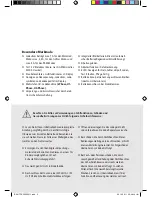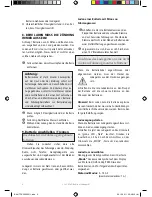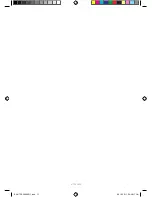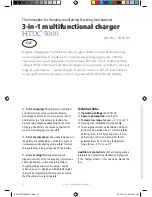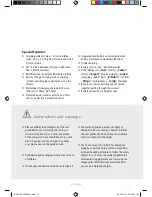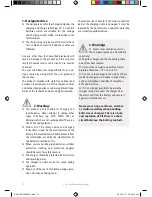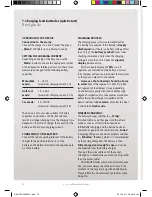
The green
„
Netz
“ (
Mains
) LED lights up after
connecting the charger to the 230 V electrical mains.
You should now use the mode button to select the
type of use (motorbike symbol, golf cart symbol
or car symbol). As soon as a 12 V lead battery is
connected (optionally acid, gel, AGM, EXIDE gel
battery), the device switches to checking mode. If
incorrect polarity is determined, the red „
Verpolt
“
(
reverse polarity
) LED lights up.
If the voltage of a battery which is connected proper-
ly is less than 7 V, the „
Defekt
“ (
Error
) LED lights
up, and the error message („
Err 002
“) appears on
the display. This indicates that the connected battery
is not a 12 V type, or it is another type of fault (e.g. as
a result of deep discharge). If the measured battery
voltage is greater than 14.3 V, the error message for
overvoltage („
Err 003
“) appears on the display.
The actual charging process only begins if the
vol tage is in the range from
7.0...14.3 V
.
CHArGING TECHNOLOGY:
The device has three successive charging phases:
I-Phase, U1-Phase and U2-Phase
I-Phase:
The charging current is approx.
1 A or 2.5 A or 5 A depending on
the mode of operation
u1-Phase:
Main charging phase with a
constant voltage of 14.3 V
u2-Phase:
Trickle charging with a constant
voltage of 13.8 V.
CHArGING:
If when the battery is connected the device identifi es
a
deep discharge
(<10.5 V), a fl ashing
battery
symbol
appears on the display and at the same
time the charging process begins. Only when the
charging voltage is more than 10.5 V is the
capaci-
ty display
activated (segment bar on the display).
Initially, a constant current is supplied (I-Phase)
until the fi nal charging voltage of 14.3 V is reached.
The charger then switches to a constant voltage
(U1-Phase), with the charging current automatically
adjusting to the state of charge of the battery; the
fuller the battery is, the more the charging current
is reduced.
If the charging current is less than approx. 300 mA,
the charger automatically switches to test mode;
this is indicated by the „
Laden
“ (
Charging
)
LED going out and the „
Test
“ LED lighting up. In
test mode, the battery is supplied with a defi ned
current. If during this charging the voltage drops
below the nominal value, this indicates excessively
large internal resistance or heavy sulphation of the
battery. If the test produces a negative result, the
battery is classifi ed as „
defective
“. The device
then switches off and the „
Defekt
“ (
Error
) LED
lights up; the error message N1 („
Err 001
“) appears
on the display.
But as soon as all of the test criteria are fulfi lled
and the battery has been evaulated as „good“,
the „
Fertig
“ (
Finished
) LED is switched on, and
the device switches to refresh mode. The „
Test
“
LED also extinguishes and the program switches to
„
Erhalten
“ (
refresh
) (U2-Phase), which is again
indicated by the corresponding LED. The battery is
then fully charged and ready for use and it can be
disconnected from the charger. But if the battery
remains connected to the charger, two processes
take place alternately, namely „
refresh
“ and
„
Main tenance
“. These two additional programs
en sure that, after the actual charging process, the
bat tery always remains in the fully charged and
optimum state.
8. Charging lead batteries
The charging process in detail
HTDC 5000
17
BA-HTDC5000-2011.indd 17
26.10.2011 20:28:19 Uhr

